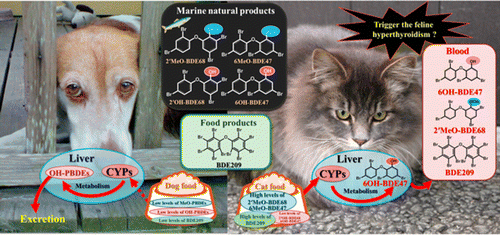Over the past three decades, the number of cats diagnosed with hyperthyroidism has increased. According to research reports, many factors such as exposure to flame retardants could be responsible, and now a new study in ACS' journal Environmental Science & Technology points in another direction. It suggests that fish-flavored cat food could be among the culprits.
Hyperthyroidism is a hormonal disorder that can cause weight loss, hyperactivity, aggression, vomiting and other symptoms in cats. No one knows for sure what causes it. But some studies have suggested a connection between environmental pollutants including polychlorinated biphenyls (PCBs) and polybrominated diphenyl ethers (PBDEs), which have been banned in many countries because they could potentially harm humans. Previous studies have detected these compounds and their byproducts in blood samples from cats. But the byproducts, which can also have toxic effects, could come naturally from other sources such as fish, a common ingredient in cat food. Hazuki Mizukawa, Kei Nomiyama and colleagues wanted to investigate whether cats were getting exposed from their fish-flavored food.
The researchers tested cat food and blood samples from cats. They also simulated how a feline's body would process various PCB- and PBDE-related compounds. Based on their results, the team concluded that the byproducts that were detected at high levels in cats' blood samples likely came from fish-flavored food and not exposure to PCBs or PBDEs. The researchers say further work is needed to clarify whether these metabolites specifically contribute to hyperthyroidism.
More information: Hazuki Mizukawa et al. Organohalogen Compounds in Pet Dog and Cat: Do Pets Biotransform Natural Brominated Products in Food to Harmful Hydroxlated Substances?, Environmental Science & Technology (2016). DOI: 10.1021/acs.est.5b04216
Abstract
There are growing concerns about the increase in hyperthyroidism in pet cats due to exposure to organohalogen contaminants and their hydroxylated metabolites. This study investigated the blood contaminants polychlorinated biphenyls (PCBs) and polybrominated diphenyl ethers (PBDEs) and their hydroxylated and methoxylated derivatives (OH-PCBs, OH-PBDEs, and MeO-PBDEs), in pet dogs and cats. We also measured the residue levels of these compounds in commercially available pet foods. Chemical analyses of PCBs and OH-PCBs showed that the OH-PCB levels were 1 to 2 orders of magnitude lower in cat and dog food products than in their blood, suggesting that the origin of OH-PCBs in pet dogs and cats is PCBs ingested with their food. The major congeners of OH-/MeO-PBDEs identified in both pet food products and blood were natural products (6OH-/MeO-BDE47 and 2′OH-/MeO-BDE68) from marine organisms. In particular, higher concentrations of 6OH-BDE47 than 2′OH-BDE68 and two MeO-PBDE congeners were observed in the cat blood, although MeO-BDEs were dominant in cat foods, suggesting the efficient biotransformation of 6OH-BDE47 from 6MeO-BDE47 in cats. We performed in vitro demethylation experiments to confirm the biotransformation of MeO-PBDEs to OH-PBDEs using liver microsomes. The results showed that 6MeO-BDE47 and 2′MeO-BDE68 were demethylated to 6OH-BDE47 and 2′OH-BDE68 in both animals, whereas no hydroxylated metabolite from BDE47 was detected. The present study suggests that pet cats are exposed to MeO-PBDEs through cat food products containing fish flavors and that the OH-PBDEs in cat blood are derived from the CYP-dependent demethylation of naturally occurring MeO-PBDE congeners, not from the hydroxylation of PBDEs.
Journal information: Environmental Science & Technology
Provided by American Chemical Society





















